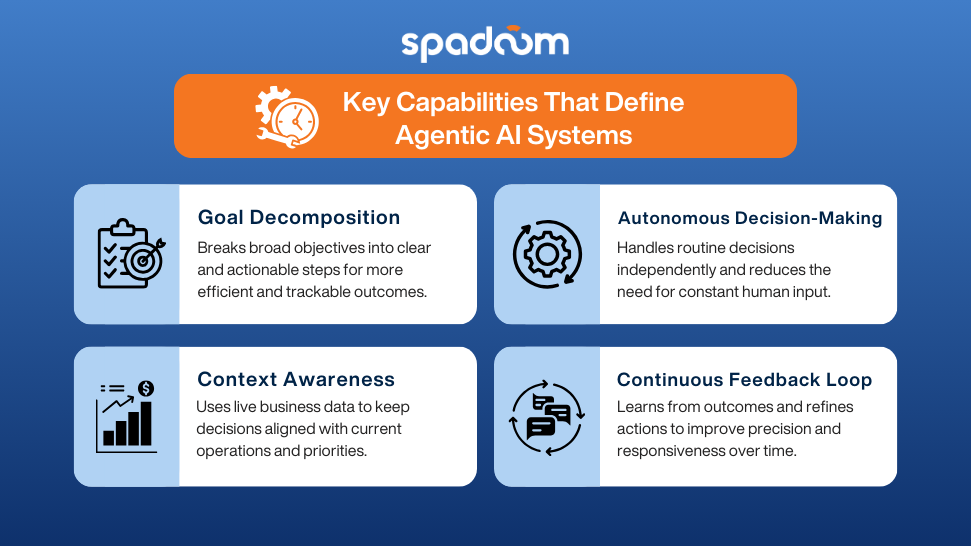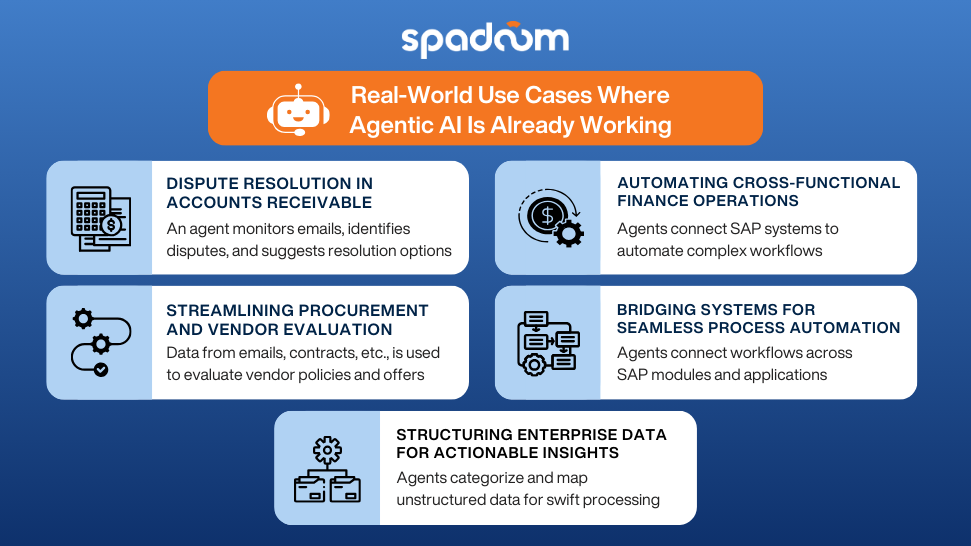Many companies have adopted AI to handle routine business tasks, things like processing transactions, analyzing performance metrics, or generating written outputs on demand. While these solutions have helped speed up work, most are still limited by one core constraint: they only act when told.
Agentic AI changes that model.
These systems are designed to operate with autonomy. Rather than waiting for prompts, they evaluate situations, prioritize actions, and carry out entire workflows independently. That means fewer handoffs, quicker responses, and decisions grounded in real-time business context. Whether it’s responding to a customer issue or coordinating supply chain steps, an agentic AI determines the right course of action and sees it through to completion.
This shift is already gaining traction in enterprise settings. According to the 2025 Global AI Survey by Fast Company, 36% of business leaders believe agentic AI workflows will deliver significantly more value than traditional AI implementations. Their perspective reflects a growing understanding that the advantage is not just about working faster but about having systems that make context-aware decisions and move processes forward without waiting for instructions.
In the sections that follow, we’ll explore what defines Agentic AI, how it differs from earlier approaches like generative AI, and how SAP is turning this shift into real, working technology.
What Is Agentic AI?
Agentic AI refers to intelligent systems that operate with a clear goal in mind. Unlike traditional tools that rely on constant instruction, these systems are built to observe, interpret, and take action independently. At the center of this model is the AI agent, a software that works within digital environments to carry out tasks based on current conditions, not just pre-written commands.
These agents follow logic designed around outcomes. For example, they can identify a stalled process, evaluate available options, and take the next step without waiting for input. Whether they are assisting with customer requests, processing vendor changes, or resolving internal service issues, the value lies in their ability to follow through.
Businesses are beginning to apply these systems in real-world settings. Reported by Sendbird, Salesforce’s Connected Shoppers Report found that 43% of retailers are already piloting agentic AI tools, a signal that this shift toward automation with decision-making power is well underway.
What Is the Difference Between Generative AI and Agentic AI?
Generative AI focuses on producing content in response to a request, such as writing a message or summarizing a report.
Agentic AI uses that same information to take action, complete the task, and handle what comes next.
For instance, while generative AI might draft an email, agentic AI sends it, monitors the reply, and schedules a follow-up based on the outcome.
Key Capabilities That Define Agentic AI Systems
The strength of any AI agent lies in what it can do beyond basic automation. These core capabilities give agentic systems the edge to act with intention, adjust in real time, and deliver measurable business outcomes.

Goal Decomposition
Agentic AI handles complex objectives by breaking them into structured, trackable actions. In HR workflows, for example, an AI agent can monitor recruitment progress, assess engagement levels, and interpret sentiment in candidate feedback, helping teams focus on the right hires while supporting long-term retention.
Autonomous Decision-Making
AI agents make operational decisions independently, within predefined parameters. They can approve recurring invoices, sort service requests, or escalate issues based on urgency, without needing human input each time.
Context Awareness
AI agents operate with full awareness of surrounding business conditions. They gather live signals from systems, such as inventory availability, customer priority levels, or past interactions, to ensure every decision reflects the current state of operations and customer needs.
For example, an agent might prioritize a high-value customer’s request when stock is limited, or adjust a fulfillment timeline based on warehouse capacity in a specific region. These decisions shift dynamically as new information comes in, helping every action stay aligned with business goals and customer expectations.
Continuous Feedback Loop
Agentic systems continually learn from the outcomes of each action. By evaluating outcomes and adjusting their future behavior accordingly, they improve precision, responsiveness, and alignment with business goals over time.
Benefits of Agentic AI in Enterprise Environments
Agentic AI is raising the standard for enterprise performance by cutting delays in workflows, improving the quality of everyday decisions, and channeling resources into the areas with the greatest impact. These advantages are already emerging across major enterprise functions.
Streamlined Operations
Agentic AI improves more than task speed; it improves how responsibilities move between people, teams, and systems. In many companies, a single workflow might pass through several hands before it’s complete.
AI agents remove that dependency by carrying out connected actions from start to finish, reducing delays caused by task ownership gaps. This makes cross-functional processes smoother and less dependent on constant follow-ups.
Faster Turnaround
Agents respond instantly to system triggers, allowing tasks to begin the moment new data becomes available. This is especially impactful in customer-facing scenarios.
Recent research from Cisco highlights that by 2028, agentic AI is expected to manage up to 68% of customer service interactions, reducing wait times and improving responsiveness at scale.
Scalable Personalization
For retail brands, integrating agentic AI into e-commerce solutions can mean smarter promotions and stronger customer engagement.
In an AI-driven e-commerce environment, these agents adjust offers, support, or timing based on real-time behavior, helping businesses personalize at speed without inflating team size.
Better Use of Data
Agentic AI is proving especially effective in environments where data labeling or review work is intensive.
In recent trials across industries like fintech and healthcare, agents helped reduce total annotation time by 52% by independently managing low-risk data and only flagging uncertain items for review. This led to faster cycles and less oversight without compromising quality.
Lower Operational Costs
As more routine decisions and actions are delegated to agents, the need for manual oversight decreases.
This naturally reduces staffing pressure while maintaining service consistency. The result is faster delivery paired with more intentional and efficient use of resources at every level.
Real-World Use Cases Where Agentic AI Is Already Working
SAP’s enterprise systems are already running agentic AI in day-to-day operations. These agents are being applied across finance, procurement, service, and HR, not in theory, but in high-volume, decision-driven workflows.
Each use case below shows how these agents operate with context, autonomy, and a measurable impact on business outcomes.
Dispute Resolution in Accounts Receivable
SAP’s financial tools now use agentic AI to help manage customer invoice disputes. An agent scans incoming messages, identifies potential issues, compiles a case summary, and recommends possible solutions.
All of this happens before a human even opens the ticket, helping teams resolve cases faster with better accuracy.
Automating Cross-Functional Finance Operations
Joule agents are also closing gaps between siloed systems in finance, operations, and customer service. When validating a payment dispute, an agent can extract invoice metadata, match customer history, verify account status, and flag anomalies, all without manual routing.
The same logic applies when reconciling cash collections. These agents reduce back-and-forth coordination and provide ready-to-act insights directly in the workflow.
Streamlining Procurement and Vendor Evaluation
Procurement teams using SAP can leverage agentic AI to evaluate vendor options without sifting through fragmented documentation. An agent can access contract PDFs, scan compliance policies, compare quotes, and summarize pros and cons based on company criteria.
It can also identify red flags such as outdated certifications or conflicting clauses. This reduces time spent manually comparing options and helps procurement teams make decisions based on full data context, not isolated inputs.
Bridging Systems for Seamless Process Automation
One of the most valuable uses of agentic AI within SAP is system bridging. Agents can connect modules like S/4HANA, SuccessFactors, and third-party applications to enable uninterrupted process execution.
When onboarding a new employee or fulfilling a sales order, for example, agents can coordinate steps across platforms without relying on human prompts to keep the process moving. This results in cleaner handoffs, fewer gaps, and fully traceable execution.
Structuring Enterprise Data for Actionable Insights
SAP agents are helping enterprises manage vast amounts of unstructured data that would otherwise slow down decision-making. A Joule agent can read incoming emails, classify them by issue type, extract critical information, and assign routing tags for downstream teams.
It can also organize invoice attachments or metadata into structured formats. For teams that rely on consistent data flow, this reduces friction and improves turnaround without needing constant intervention.
How SAP Is Bringing Agentic AI to Life Across Its Ecosystem
SAP has not treated agentic AI as an external add-on. Instead, it has embedded these capabilities into its architecture so that intelligent agents can operate across the applications businesses already rely on.
Rather than forcing users into new systems, SAP builds agentic functions directly into workflows, where they can perform with context, autonomy, and scale.
From Workflow Participant to Process Owner
What began as a generative assistant has become far more capable. Joule now acts as an autonomous participant across SAP environments, capable of initiating and completing multi-step workflows across procurement, finance, and supply chain.
These agents are trained to carry out decisions based on live data, permissions, and priorities, without pausing for prompts. Some of the best AI agents SAP has deployed are already managing tasks like vendor evaluation and invoice reconciliation, helping teams move faster while reducing overhead.
Embedded Intelligence Across the SAP Stack
The reach of these agents extends well beyond core ERP. Within SAP AI solutions like SAP Sales Cloud, Digital Manufacturing, and Integrated Business Planning, Joule leverages the SAP Knowledge Graph to draw insights and trigger tasks based on user behavior, business logic, or system conditions.
These same agents can operate in environments like Concur, Signavio, and LeanIX, enabling cross-application coordination without switching interfaces or losing context.
SAP’s approach doesn’t treat intelligence as an add-on. It’s built into every layer of the enterprise, creating the structure needed for agentic AI to deliver value in real, operational terms.
Considerations Before Deploying Agentic AI in Your Business
Bringing agentic AI into an enterprise is not a switch you flip. These systems tie directly into live data, established business rules, and everyday workflows, which means the way they run and the way they are governed have to be designed into the rollout from the start.
Data Readiness
AI agents make decisions based on what they see in real time. If the data feeding those decisions is incomplete or outdated, the risk of flawed actions increases.
Organizations should evaluate the health of their data pipelines and ensure that the systems feeding agentic workflows are connected and synchronized. Deploying the best AI agents depends on having structured workflows and clean data sources that reflect current operational realities.
Process Visibility
Before assigning agents to execute tasks, businesses need a clear view of how those tasks actually run. That includes knowing what steps are involved, where bottlenecks happen, and which teams are responsible.
A mapped process is easier to automate effectively, and makes it easier to track agent performance over time without losing control or clarity.
Governance and Control
Autonomy requires oversight. Agentic systems should be deployed with defined boundaries, decision rights, and auditability. In compliance-heavy industries, these controls are not optional.
SAP supports this through built-in explainability features that allow teams to understand how an agent arrived at a decision and intervene when necessary.
Human-AI Collaboration
Agentic AI should not operate in isolation. It needs to work within the boundaries of team structures and human decision-making authority. When agents are seen as collaborators rather than replacements, adoption improves and value grows. A clear role definition helps avoid confusion and builds trust in the system.
With these considerations in place, companies can scale agentic capabilities more confidently and with greater long-term impact.
Final thoughts: Agentic AI Is Already at Work, Are You Ready to Use It?
Enterprise AI has reached a point where systems no longer just support workflows; they help run them. Agentic AI is already live in environments like SAP, where agents are making operational decisions, executing tasks, and coordinating across platforms without constant oversight. This isn’t a shift happening in the future. It’s happening now, inside the tools many businesses already use.
The responsibility is no longer about evaluating if agentic AI is viable. It’s about determining whether your operations are prepared to use it well. This includes aligning teams, cleaning up data flows, and assigning clear roles for when and how agents act. As these systems evolve, the value won’t come from isolated wins but from how smoothly they fit into your organization’s existing rhythm.
SAP has already laid the groundwork. The question is whether your business is ready to take advantage of it. As intelligent systems begin taking on decisions, the organizations that shape their use with clear direction and strong governance will be the ones that see measurable results.
Partner with Spadoom to Put Agentic AI into Action
Spadoom helps organizations put agentic AI to practical use inside the SAP tools they already rely on. Our team works closely with clients to shape solutions that fit how they operate, so progress feels natural and adoption comes with less resistance.
With deep expertise in SAP consulting for European businesses, we help companies apply these systems in ways that align with local compliance, sector dynamics, and process design. Whether you’re exploring use cases or ready to move into deployment, we’re here to guide you.
Contact us today to learn how Spadoom can help you build more capable, connected systems with SAP AI.
Frequently Asked Questions (FAQs)
What is the meaning of agentic AI?
Agentic AI refers to AI systems that can plan, act, learn, and improve autonomously. Unlike standard AI models, these systems break down large goals into smaller tasks and make decisions based on context, without requiring constant human input.
What is an example of agentic AI?
An example of agentic AI is a digital assistant that books a trip end-to-end: it checks calendars, books flights, compares hotels, and updates your schedule, without needing step-by-step commands.
What is the difference between GenAI and agentic AI?
Generative AI is primarily used for creating content, such as text, images, or code, based on user prompts. Agentic AI goes further. It can plan and execute multi-step workflows, adjust in real-time, and operate more like a smart assistant than a content tool.
Is agentic AI based on LLMs?
Yes, many agentic AI systems are built on large language models (LLMs), which allow them to understand context, reason through tasks, and interact using natural language.
Is agentic AI the next big thing?
Many experts believe it is. Agentic AI represents a significant shift, moving away from tools that merely assist to systems that can independently carry out tasks, adapt to feedback, and even take initiative in business workflows.



